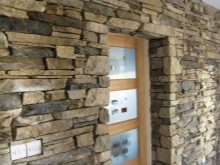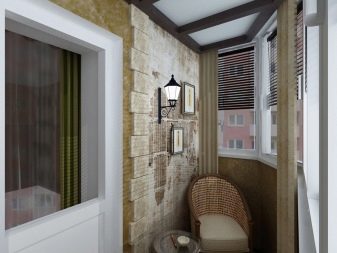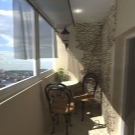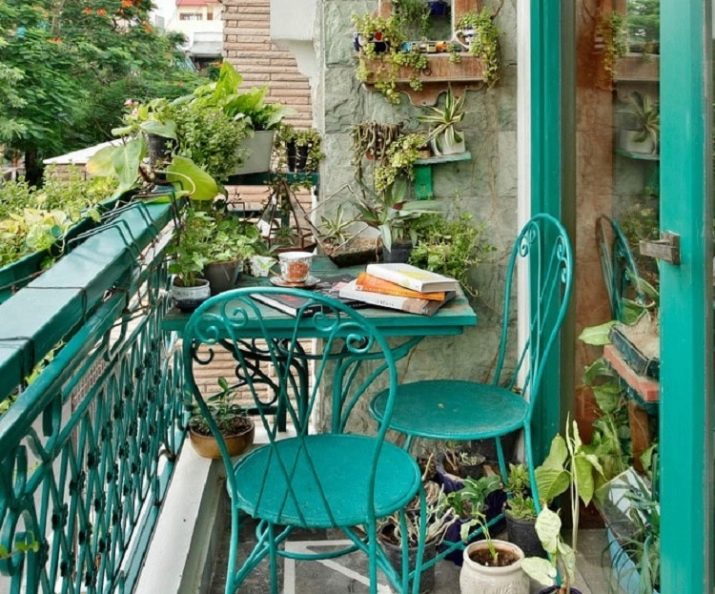The balconies of most people from a place to store unnecessary things are increasingly turning into the original lounge area, a resting place. It is not surprising that one of the most important issues in this case is the choice of a suitable interior, in particular, wall and floor finishes. Along with the popular plastic and wood, stone is also used. What are the features of lining the balcony with stone?






Advantages and disadvantages
Stone decoration is always associated with luxury, respectability, comfort. It is optimally suited for open verandas and terraces, balconies. Decorating the latter with stone allows you to make notes of a free rustic atmosphere, ranch style in living conditions in a city apartment.
Such a design option is always associated with a certain continuity, comfort, reliability. And, indeed, the finishing stone is distinguished by increased strength characteristics, is not afraid of temperature changes, and is fireproof.


Against the background of balconies, inside sheathed with wood and plastic (the most popular materials), the “stone” balcony will favorably differ, look stylish and unique.
However, the material blends well with ceramic tiles, wood, stucco and others for interior decoration.
The disadvantage of stone cladding (natural or artificial) is the need to strengthen work surfaces. If we talk about the installation of natural stone, then you should first achieve a flat surface, select stones of a suitable size. For their processing and preparation, special tools are required, which also complicates the work and contributes to their cost.


If we compare the wooden balcony with stone trim, then the second option can not be called eco-friendly. Natural stone always has a small but radiation background. Artificial - contains various additives of chemical origin (thickeners, dyes).


Species overview
Stone decoration is the common name for a design option. This idea can be embodied using various materials. Consider the main ones, the use of which allows you to achieve the feeling that the balcony is decorated with stone.
Natural
Material used extremely rarely when decorating a balcony. This is due to its high weight and high cost. Besides, the stone itself requires pre-treatment before use. But even this is not able to cancel the radiation radiation characteristic of natural stone.
In addition, it is susceptible to temperature, moisture. The installation of natural stone requires the mandatory strengthening of work surfaces, the involvement of specialists with special equipment.



Decorative (artificial)
A material that is as close as possible in appearance and texture to natural stone. However, the decorative counterpart is lighter, cheaper and has no harmful emissions. It can be made in the form of wall panels or individual elements.
Due to its performance decorative material can be used in conditions of high humidity and low temperatures. It has high fire performance, is not afraid of elevated temperatures, moisture. Moreover, the material has high thermal insulation properties. Even without the use of insulation, the creation of a continuous coating of decorative stone allows you to make the balcony noticeably warmer.




It is worth noting the biological, environmental safety of artificial stone. It is not subject to decay, mold does not form on its surface, insects do not start.
Among the advantages - ease of installation. For laying does not require special building skills, special tools. The stone is glued to the surface with a special composition. On sale there are straight and angular elements, which also simplifies the installation of the system.
Use of decorative stone valid on a balcony of any size and style. A variety of color options, imitations allows you to choose the right one.
In terms of its service life, decorative stone is comparable to the period of operation of concrete and brick. It is easy to maintain, withstands mechanical damage.



The artificial analogue in turn also has several varieties. It can be an imitation of polished or natural (with irregularities) stone. The latter is usually an imitation of raw granite, quartz with uneven edges, bulges. Polished stone is porcelain stoneware or industrial granite with natural stone chips in the composition.


Decorative material with its appearance may also resemble rubble (river pebbles of a large fraction, wild unprocessed stone) or cut, sawn (smooth surface imitating limestone, sandstone) stone, as well as various bricks. As for the shades, it is either natural colors or a bright unusual palette that is not found among natural stones.



Separately, it is worth mentioning the artificial variety - agglomerate. This is a frost-resistant material, based on granite or marble chips, which ensures its increased strength. It is usually used for laying as a floor covering, although it is also suitable for wall decoration.


According to the form of release, as already noted, artificial stone may take the form of wall panels or individual elements. The former are more convenient to install, their use allows you to quickly perform lining. The material is easy to cut, can be mounted on self-tapping screws or glued with special glue (provided perfectly smooth working surfaces).
However, if you need only individual elements and in a small amount, it is more convenient to select these immediately and not cut them out of the panel.


Panel sizes vary.
- Leafy. The largest, their length is usually about 2 meters, width - 1 meter. Optimum for large rooms with a minimum of angles and bends.

- Tiled. They are square “tiles” suitable for finishing the lower part of the balcony (for example, the space under the windows), for a limited area. Suitable for beginners who are lining alone, it is physically easier to fix them than larger wall panels).

- Rack and pinion. They are panels of the type of rails, differing in size. Convenient for cladding window and doorways.

Design options
Most often, not solid surfaces are trimmed with a stone, but separate parts of the balcony. The stone goes well with stucco and wood, which gives a feeling of comfort, natural design. As a rule, corners, window and doorways make out with a stone. Such an interior blends well with green plants, wicker furniture, bleached linen or, conversely, bright colored textiles.

Similarly, facing with a stone imitating masonry can be performed.

On cold (open) balconies, stone decoration is recommended to be done on a wall adjacent to the room. In warm (closed) balconies with stone you can sheathe any of the surfaces.
You can combine different materials on the basis of color similarity or contrast. On light walls, darker stone elements harmoniously look. A dark brickwork, on the contrary, it is better to dilute with a lighter stitching.
It is better to combine stones of unusual shades with analogs of calmer natural shades. Such a decision will be successful in oriental, eclectic interiors, in the spirit of art deco.


You can use different combinations of stones. As a rule, a rougher stone becomes a detail of the interior. They are faced with one of the walls or decorated with door and window openings.
When decorating a balcony with a stone, it is important to remember that the more calm the stone will be in color and texture, the more bright and intricate the interior can be selected for it. The same rule works in the opposite direction.


Material Selection Criteria
When choosing a decorative stone, pay attention to its composition. If you need a bright balcony, for example, in the Scandinavian style, you should choose a material based on white cement. It will help to recreate the necessary style, but at the same time it will be more expensive.
The most durable artificial option - with sand as a filler. It is characterized by a longer service life, but also will be more difficult. Such material will require special glue and, possibly, the strengthening of work surfaces.

Plaster-based artificial material is especially popular. However, for a loggia, including a closed one, it is not suitable.
This is due to the ability of gypsum to lose its operational properties upon contact with water, increasing the humidity level in the room. When choosing a gypsum-based material, it will need to be varnished after installation.
When buying a decorative stone, you need to evaluate the quality of the coating - it should not be too porous, have impregnations of extraneous elements, uneven color. Materials painted in bulk, not only superficially, retain color longer, do not fade.




One of the main rules of organizing the interior is - light colors make the room more spacious. This is true for the design of balconies. The larger the area lined with stone, the lighter should be its shade.
For small balconies, it is better to choose a smaller material (brick, medium-sized stones). Stones of any size are suitable for spacious loggias.






Beautiful examples
As already mentioned, stone cladding successfully fits into any interior. Including - in modern hi-tech loft. For these directions, it is recommended to choose a stone - imitation of brickwork or large stones with a smooth surface. Surprisingly, they can even be combined with plastic.

Another laconic version modern style. The emphasis of the interior is a red brick wall with contrasting trim. As an addition, bag chairs are used.

Most of the walls are finished with light brickwork, the texture of which is emphasized by a gray-granite painted wall. It is the difference in textures, the contrast of colors that attracts attention. Searchlights are another source of light - another design feature.

Perhaps one of the most pleasant options for a city dweller is light brick cladding, light furniture, green plants. Pay attention to how well the floor covering is chosen - small ceramic tiles laid diagonally. The interior turned out quite calm, but not boring. As a bright accent stands the greenery of plants.

If minimalism is closer to you in spirit, here one of the possible options for the interior of the balcony. One of the walls is decorated with a large stone imitating natural. White-gray shades make the balcony visually more spacious, add “air” to the space. Brighter accessories help to avoid boredom, and wooden boxes emphasize the idea of environmental friendliness.

A similar interior can be easily found in houses on the seafront, a great idea for a summer terrace. However, in the conditions of a city apartment, such decoration and interior are also very organic.
Here we see the use of unpolished stone and plaster. The atmosphere of comfort and environmental friendliness is emphasized by wooden floors and furniture. A panoramic window complements the feeling of easy country life.

On open loggias wild stone or imitation of it looks original, as well as aged brickwork. In the spirit of charming French loggias, you can organize “crowding” on such a balcony from an armchair, a small table and an abundance of wicker greenery. An elegant coffee set and a warm plaid will be a great addition to such an interior.

The noble combination of dark brick with lining and panoramic windows with dark profiles makes the balcony respectable and stylish. Along the windows there is a design resembling a bar counter shape. Chairs with high legs complement the interior.

On how to trim the balcony with stone, see below.










